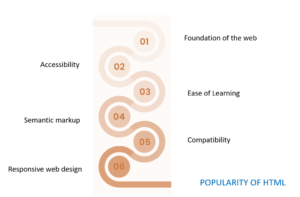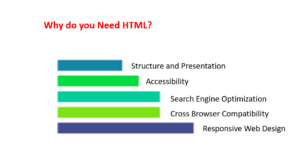Introduction
As we navigate the digital landscape of 2023, HTML (Hypertext Markup Language) continues to stand as the cornerstone of web development. In this era of ever-evolving technologies, it’s crucial to stay updated on the essential features of HTML that empower developers and content creators to shape the web as we know it.
HTML, which has been with us since the inception of the World Wide Web, has seen significant advancements over the years. In this article, we will delve into the key features that make HTML indispensable in 2023. From its user-friendly syntax to its role in enabling progressive web applications (PWAs), HTML remains a foundational tool in the toolkit of every web professional.

Popularity of HTML
HTML (Hypertext Markup Language) has been a central technology in web development since its inception, and its popularity remains unwavering in 2023. Several factors contribute to HTML’s enduring popularity:
Foundation of the Web
HTML is the fundamental language used to structure and present content on the World Wide Web. It forms the backbone of virtually every website and web application, making it an essential skill for web developers and designers.
Accessibility
HTML is an open standard and is accessible to anyone. It doesn’t require specialized software or tools to create web content. All that’s needed is a simple text editor, which makes it highly accessible for both beginners and experienced developers.
Ease of Learning
HTML’s syntax is straightforward and easy to learn, even for individuals with no prior programming experience. This simplicity encourages newcomers to web development and lowers the entry barrier.
Semantic Markup
The introduction of semantic elements in HTML5, such as <header>, <nav>, <article>, and <footer>, has enhanced its capabilities. These elements provide meaning and context to content, improving both accessibility and search engine optimization (SEO).
Compatibility
HTML is supported by all modern web browsers, ensuring that web content built with HTML can be viewed by users on various devices and platforms without compatibility issues.
Responsive Web Design
HTML, in conjunction with CSS (Cascading Style Sheets) and JavaScript, plays a pivotal role in creating responsive web designs. This allows websites to adapt to different screen sizes and orientations, catering to the growing use of mobile devices.

Why do you Need HTML?
Structure and Presentation
HTML is used to structure and present content on the internet. It defines the basic elements of a web page, such as headings, paragraphs, lists, links, and multimedia. Without HTML, web browsers wouldn’t know how to render and display web content.
Accessibility
HTML allows you to create web content that is accessible to everyone, including individuals with disabilities. By using semantic HTML elements and attributes, you can provide meaningful information about the content’s structure, which is crucial for screen readers and other assistive technologies.
Search Engine Optimization (SEO)
HTML plays a critical role in SEO. Search engines use HTML tags and attributes to understand the content and structure of web pages. Properly structured HTML, along with meta tags and schema markup, can improve your website’s visibility in search engine results, driving organic traffic.
Cross-Browser Compatibility
HTML is supported by all major web browsers, including Chrome, Firefox, Safari, and Edge. This ensures that web content created with HTML is accessible to users across different browsers and platforms, promoting a consistent user experience.
Responsive Web Design
HTML, in combination with CSS (Cascading Style Sheets), allows you to create responsive web designs. You can use HTML to define the structure of a web page and CSS to control its layout and appearance, ensuring that your site looks and functions well on various devices and screen sizes.

Top HTML Features
User Friendly & Simple
HTML is known for its user-friendly and simple syntax, making it accessible to both beginners and experienced developers. It consists of a series of tags that define the structure and content of web pages.
Semantic Structure
HTML offers semantic elements like <header>, <nav>, <article>, and <footer, which provide meaning and context to content. This semantic markup improves accessibility for users with disabilities and enhances SEO.
SEO – Search Engine Optimization
Properly structured HTML, including meta tags and semantic elements, can significantly impact a website’s search engine ranking. SEO professionals use HTML to optimize content for search engines, driving organic traffic.
localStorage & IndexedDB – Client-side data storage
HTML5 introduced client-side storage options like localStorage and IndexedDB. These features allow web applications to store data locally on a user’s device, reducing server requests and improving performance.
Offline Capabilities (PWA) with Cache API & Service Workers
HTML, in conjunction with technologies like the Cache API and Service Workers, enables the development of Progressive Web Apps (PWAs). PWAs offer offline capabilities, caching, and a seamless user experience even without an internet connection.
Canvas for Game Development
The <canvas> element in HTML5 allows developers to draw graphics and animations directly in the browser using JavaScript. This feature has opened up possibilities for web-based game development and interactive visualizations.
Platform Independent
HTML is platform-independent, meaning web content created with HTML can run on various operating systems and devices without modification. This versatility makes it a popular choice for cross-platform web applications.
Media Support
HTML provides excellent support for multimedia elements such as images, audio, and video. HTML5 expanded on this by supporting various video and audio codecs, making it easier to integrate multimedia content into web pages.
Conclusion
HTML remains an integral part of web development in 2023. Its simplicity, semantic structure, SEO capabilities, and support for client-side data storage and offline functionality make it a powerful tool for creating modern web applications. Understanding and mastering HTML is essential for anyone involved in web development or content creation in today’s digital landscape.
FAQ’S
1.What is HTML, and why is it important in 2023?
HTML, or Hypertext Markup Language, is a fundamental technology for structuring and presenting content on the web. It remains important in 2023 because it serves as the backbone of web development, enabling developers to create websites and web applications.
2.How does HTML contribute to better SEO in 2023?
HTML plays a crucial role in SEO by allowing developers to structure content using semantic elements, optimize meta tags, and implement schema markup. These practices enhance a website’s visibility in search engine results, driving organic traffic.
3.What are the benefits of using semantic HTML elements in 2023?
Semantic HTML elements like <header>, <nav>, and <footer> provide meaning and context to web content. In 2023, they improve accessibility for users with disabilities and help search engines understand the content’s structure, leading to better SEO.
4.How can HTML be used for client-side data storage in 2023?
HTML5 introduced features like localStorage and IndexedDB, enabling web applications to store data locally on a user’s device. This reduces the need for constant server requests and improves performance.
5.What are Progressive Web Apps (PWAs), and how does HTML contribute to their development in 2023?
PWAs are web applications that offer offline capabilities, caching, and a seamless user experience. HTML, along with technologies like the Cache API and Service Workers, enables the creation of PWAs by allowing web content to function even when the user is offline.
6.How has HTML evolved for game development in 2023?
HTML5 introduced the <canvas> element, which allows developers to draw graphics and animations directly in the browser using JavaScript. This feature has opened up possibilities for web-based game development and interactive visualizations.

